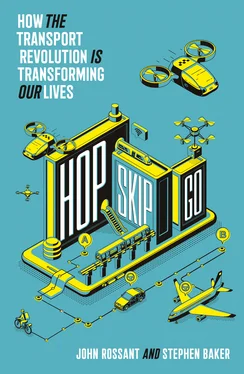Billions of us are still tied to cars and trucks. Some of us adore them. Others drive simply because in the world created by cars, the car remains the best way to get from here to there. That’s why automobiles have essentially run the world, and much of its economy, for the last century.
But now the entire car economy, from giants like Toyota and Ford to Daimler, has to find its place in a world of connected vehicles, most of them running on electricity. Oil companies also face existential challenges. The move away from the internal combustion engine threatens to eviscerate the market for gasoline, which currently accounts for nearly half of the oil we consume. That could lead to a collapse of oil prices. The need for lithium and a host of rare earth minerals, all of which are key battery components, could spark mad rushes to Chile and the Democratic Republic of Congo. Disruption awaits everywhere.
Consumers, meanwhile, will be facing a smorgasbord of new possibilities. A host of start-ups, such as companies like Arcimoto, in Oregon, are building new types of mobility machines. Arcimoto’s electric buggy is a three-wheeled blend of a car and cycle, with a roof. In China’s provincial capitals, the streets teem with bike-like microcars. They’re slow, with a range of only seventy miles, and they have as much protective armor as a toaster. But some of them cost only $1,000. Mobility at its most basic level is going to get extremely cheap.
This shift toward networked mobility will also stir up social questions, many of them fraught. While the automobile economy created and still sustains tens of millions of middle-class jobs, AI and robotics enrich a much smaller technology elite. The migration of mobility toward the digital economy threatens to widen the global gap between haves and have-nots. What’s more, cities are the laboratories for this revolution. If new mobility options enhance their competitiveness and lift the urban quality of life, they’re likely to attract even more talent—in turn exacerbating the city-country divide.
THIS STORY OF movement is almost as big as the earth itself. So how do we tell it?
We start with the people who are putting it together—creating the flying machines, electric cars, AI-fueled services, and new networks that will change the way we move. The people we’ll meet in each chapter represent entire ecosystems of activity. There’s Kevin Czinger, the founder of Divergent 3D. Headquartered just a few miles south of LA’s airport, Divergent is building an entirely new automobile manufacturing setup. The car is designed on a computer, its parts spit out by 3-D printers and then assembled largely by a team of robots. If you’re not happy with it, you melt the pieces, tweak the design, and try again. That’s the advantage of a software economy. It’s easy to change and to try things. It’s why innovation comes so fast. The world of mobility is facing whirlwinds of it.
We’ll also explore one of the most ambitious education efforts currently under way in artificial intelligence: the race on three continents to teach machines how to drive. We’ll see a Chinese cartographer named Wei Luo, in a Palo Alto start-up, DeepMap. She’s building a new generation of maps, which direct autonomous cars by the centimeter and alert them to fender benders and fallen branches. This is a new rendering of geography for a different and infinitely more exacting consumer: a machine. Meanwhile, in China’s southern megapolis of Guangzhou (once known as Canton), scientists at a start-up called Pony.ai are fine-tuning the cognitive processes of autonomous cars running down their streets, while trying to figure out how much of what they learn in China, or in California, will work in Rome or Cape Town.
Building systems that can navigate the physical complexity of the world by themselves, while also dealing with swarms of impetuous, irrational, jaywalking, drive-texting humans, will be one of the towering technological feats of the century. For most of the coming decade, though, the lion’s share of business in autonomy will be for applications that can make money while smart cars are still undergoing their apprenticeship. In other words, while full autonomy is the research goal, semiautonomy will be the bigger market, at least over the next few years.
Robert “RJ” Scaringe, founder of the electric car start-up Rivian, whom we’ll meet in chapter 3
, imagines a semiautonomous feature for his coming electric SUVs and pickups: a guided autonomous tour of a national park—maybe Yellowstone or South Africa’s Kruger. The car will drive itself on a premapped course, as if on train tracks, and provide commentary en route. This will not be full autonomy, but it should offer enough of it for the driver to turn around and gape at a bear or a giraffe, and even to take pictures while the wheel turns itself. This apprenticeship will be valuable not only for the cars (or whatever we end up calling them). It will also introduce us to autonomy little by little, so that when machines are finally fully capable of navigating the surface of the earth, we might not find them scary. Maybe by then we’ll have figured out how to regulate them.
Not all the new movement will be happening on land. A host of companies, from start-ups to aviation titans like Airbus and Boeing, are engineering a new generation of flying machines. An engineer named Mark Moore worked for three decades at NASA to develop robotic flying craft. For much of that time, they seemed less likely than the robots destined for Mars. Yet now more than one hundred companies around the world are building these electric airships and whirlybirds, and Moore has jumped from NASA to Uber, where the plan is to operate networks of robotic flying taxis in cities, starting with Los Angeles and Dallas. Flying pods sound even more exotic than driverless cars, and yes, there are all sorts of legal and regulatory wrinkles to iron out. But once these vessels are up in the air, they face a simpler mission than that of autonomous cars, simply because the sky is a lot less busy than our tangled world below.
Other mobility ventures are driven less by cutting-edge technology than by imagination and entrepreneurship. In 2010, Nadiem Makarim, a young Indonesian, had the idea to organize so-called ojeks, or motorcycle taxis, into a ride-sharing network, Go-Jek. He launched in Jakarta with twenty of them, and now Go-Jek has more than a million of these two-wheeled chauffeurs, and the company is spreading throughout south Asia. Once Makarim had his mobility app on millions of phones, he started to use it to deliver a host of other services, from banking and massages to package delivery. His company runs on data, and it operates one of the biggest AI labs in Southeast Asia. Little wonder Google recently led a $1 billion investment round for a stake in it.
THIS THIRD STAGE of the digital age differs from its PC and smartphone predecessors in two fundamental aspects. The first has to do with geography. The first network boom was largely local: a handful of companies on the West Coast of the United States defined the Internet revolution and towered above it. The dominant smartphone platforms—those produced by Apple and Google—came from the same neighborhood. But the mobility revolution, from its very inception, has been a global phenomenon. China is on equal footing with the United States, if not ahead of it. Israel is a key technology player, as are European hot spots like Berlin. Entrepreneurs in Nigeria, Indonesia, and Mexico are creating transformative networks that can catapult them into international markets. In short, the mobility revolution is exploding everywhere.
Читать дальше












